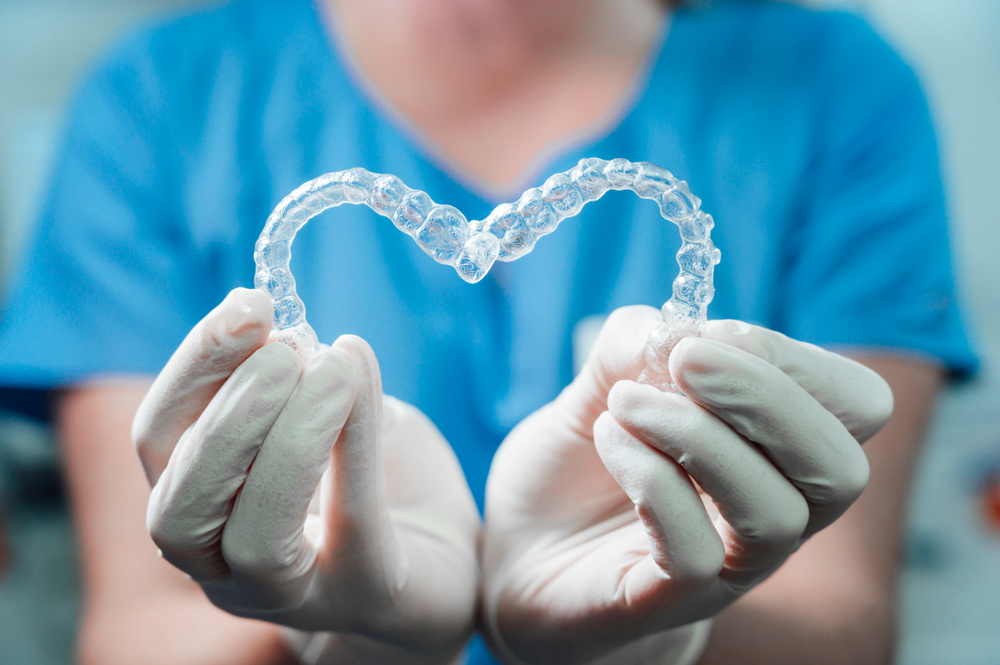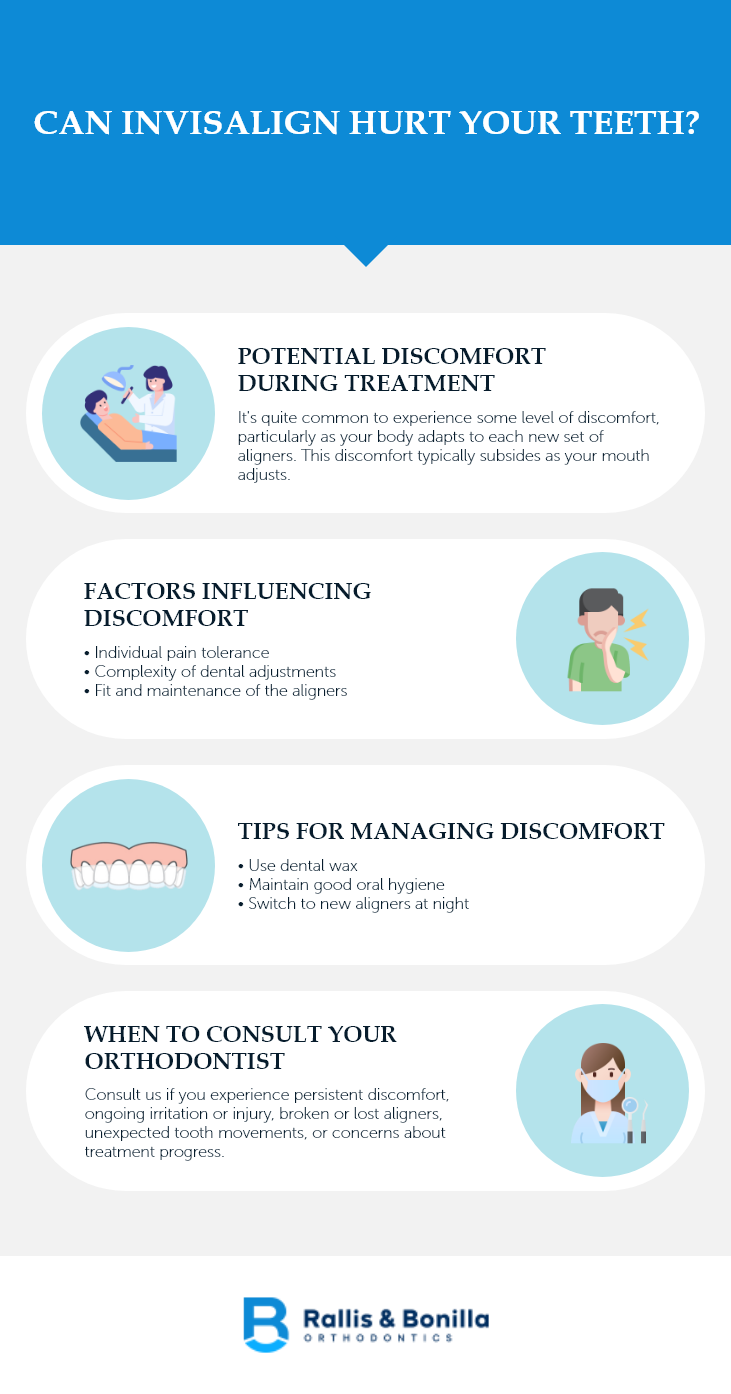Invisalign has revolutionized the way we approach teeth straightening, offering a discreet and flexible alternative to traditional metal braces. While it’s celebrated for its convenience and aesthetic appeal, many wonder if Invisalign could cause discomfort or harm to their teeth. This blog post will explore the realities of wearing Invisalign, address common concerns, and offer insight on how to handle any potential discomfort. Whether you’re considering Invisalign or are just curious, we aim to provide you with clear, helpful information so you can make an informed decision about your dental health.
Potential Discomfort During Treatment
During Invisalign treatment, it’s quite common to experience some level of discomfort, particularly as your body adapts to each new set of aligners. This discomfort is usually most noticeable during the first few days after starting a new set of aligners and typically subsides as your mouth adjusts.
Here are a few potential sources of discomfort:
- Pressure on Teeth – Each new aligner tray is designed to move your teeth gradually. The pressure needed to achieve this movement can lead to temporary discomfort, similar to the sensation experienced with traditional metal braces.
- Edge Irritation – Sometimes, the edges of the aligners can irritate the gums or the inside of your mouth. This usually diminishes as your mouth becomes accustomed to the aligners, but if it persists, we can smooth out any bothersome edges.
- Jaw Discomfort – As your teeth move, changes in how your jaws align can temporarily affect how comfortably your jaws sit together. This type of discomfort often resolves on its own as your treatment progresses.
Remember, experiencing some level of discomfort is a normal part of the teeth-straightening process. It’s a sign that your Invisalign is actively working towards giving you the smile you desire. If discomfort becomes painful or seems unusual, it’s important to inform your orthodontist to ensure everything is progressing as it should.
Factors Influencing Discomfort
When undergoing Invisalign treatment, the level of discomfort you might experience can vary due to several factors.
- Individual Pain Tolerance – Your personal pain threshold will significantly impact how you perceive discomfort during treatment. Some people might find the pressure exerted by the aligners barely noticeable, while others may feel more intense discomfort.
- Treatment Stage – Discomfort tends to be more pronounced during the initial stages of treatment and when switching to a new set of aligners. However, it usually decreases over time as your teeth adjust to the pressure.
- Treatment Complexity – The specific requirements of your orthodontic treatment can also play a role. For example, larger shifts required to correct your teeth alignment or bite issues can result in more pressure from the aligners, thereby increasing discomfort.
- Aligner Fit and Maintenance – Proper fit and care of your aligners are crucial. Aligner trays that fit well tend to cause less irritation and discomfort. Keeping them clean reduces the risk of gum inflammation or other oral health issues that could compound discomfort.
- Compliance with Wear Schedule – Invisalign should ideally be worn for 20 to 22 hours per day. Inconsistent wear can prolong the adjustment period, potentially leading to increased discomfort each time the aligners are reintroduced after a prolonged period without them.
By recognizing these factors and addressing them proactively, you can ensure a smoother and more comfortable Invisalign treatment process. Keep communicating with us about your experience, and don’t hesitate to ask for advice on managing any discomfort.
Tips for Managing Discomfort
Managing discomfort during Invisalign treatment can make the process smoother and more bearable, allowing you to focus on the exciting progress toward achieving your perfect smile. Here are some practical tips to help minimize and manage any discomfort associated with Invisalign aligners:
- Use Dental Wax – If the edges of your aligners feel sharp or irritate your gums and cheeks, applying dental wax to the problematic areas can provide a protective barrier and reduce irritation.
- Switch to New Aligners at Night – Putting in a new set of aligners before bedtime can be beneficial. This timing allows your teeth to adjust to the new aligners while you sleep, potentially reducing the initial discomfort by morning.
- Maintain Good Oral Hygiene – Keeping your teeth and aligners clean helps prevent irritation and discomfort caused by food particles and plaque buildup. Rinse your aligners every time you take them out, and brush them gently with a soft-bristled toothbrush.
- Stay Hydrated – Drinking plenty of water not only keeps you hydrated but also helps keep your mouth clean. It can reduce the feeling of dryness that some experience when first using aligners.
- Cold Compresses and Chilled Water – Applying a cold compress to the outside of your mouth can help alleviate pain and reduce inflammation. Sipping cold water can also soothe sore gums.
- Over-the-Counter Pain Relievers – If discomfort becomes distracting, consider taking over-the-counter pain relief medications, such as ibuprofen or acetaminophen, following the dosage instructions carefully.
- Soft Food Diet – During periods of heightened discomfort, opt for soft foods that require less chewing, such as yogurt, smoothies, soups, and mashed potatoes. This can prevent additional pressure and tooth pain.
- Chew Exercises – Gentle chewing exercises can help your teeth adjust to the aligners and may reduce discomfort. Use chewies, small cylindrical cushions made from a soft material provided by your orthodontist to bite down on, which can help seat the aligners properly and massage your gums.
Remember, it’s normal to experience some discomfort as your teeth adjust to each new set of aligners. These tips should help make your Invisalign journey as comfortable as possible. If you ever find the discomfort unbearable or have concerns about the fit of your aligners, don’t hesitate to contact us.
When to Consult Your Orthodontist
Navigating your Invisalign treatment with minimal discomfort is key to a smooth and successful orthodontic journey. While some discomfort is expected, knowing when to reach out to your orthodontist can ensure your treatment is on the right track and any issues are addressed promptly.
Here are some situations when consulting us is essential:
- Persistent Discomfort – If the discomfort doesn’t decrease after a few days of wearing a new set of aligners or becomes progressively worse, it’s important to consult your orthodontist. We can check if the aligners fit correctly and make any necessary adjustments.
- Improper Fit of Aligners – If your aligners don’t seem to fit snugly over your teeth or if there are significant gaps between the aligner and the teeth, it’s crucial to get in touch with us. A poor fit can hinder the effectiveness of your treatment.
- Irritation or Injury – Should you experience ongoing irritation or sores in your mouth from the aligners, your orthodontist needs to know. We can smooth out the edges of the aligners or provide alternatives to reduce irritation.
- Broken or Lost Aligners – If an aligner breaks or gets lost, contact your orthodontist immediately to get a replacement. Using a damaged aligner or skipping wear time can delay your treatment progress.
- Unexpected Tooth Movements – If you notice your teeth moving unexpectedly or not tracking as planned, your orthodontist should assess the situation. Timely intervention can correct the course of your treatment.
If you have any doubts about how your treatment is progressing or concerns about what you’re experiencing, don’t hesitate to reach out. It’s important to feel confident and informed throughout your treatment. Regular check-ins are crucial but don’t wait for your next scheduled appointment if you encounter any of the above issues. Keeping open lines of communication with us not only helps ensure that your treatment is effective but also gives you peace of mind as you work towards your new smile.
As you consider the journey toward a straighter, healthier smile with Invisalign, choosing the right orthodontic practice is crucial. Rallis & Bonilla Orthodontics, with our convenient locations at North Star, 84th Street, and Yankee Hill, is dedicated to providing you with expert, compassionate care tailored to your individual needs. Our team is committed to making your Invisalign experience as comfortable and effective as possible. Visit us at any of our locations to discover how we can help enhance your smile and your confidence through expert orthodontic care. Let’s create that beautiful smile together.

